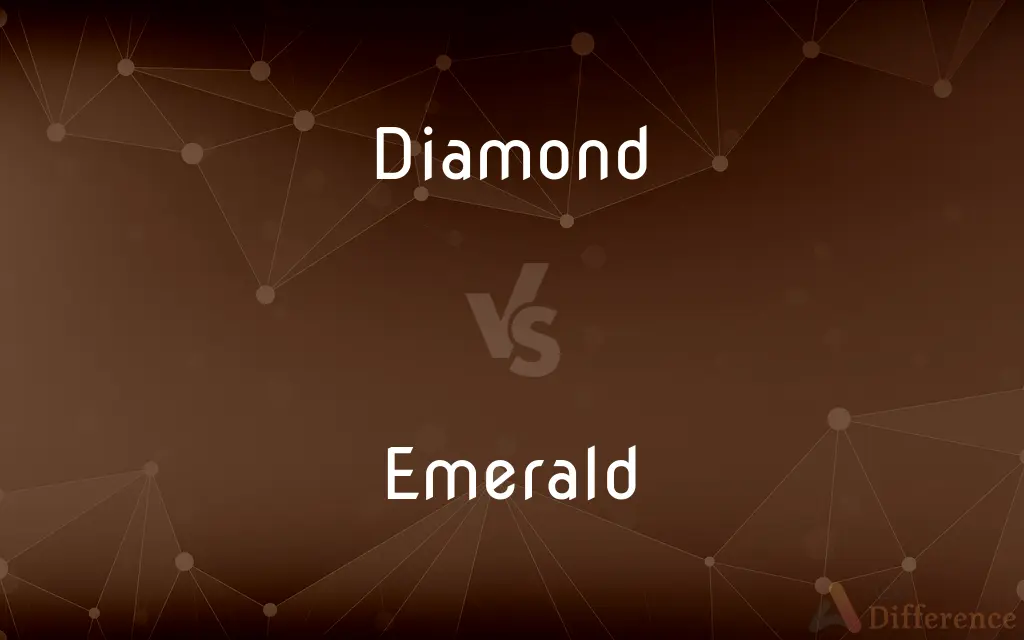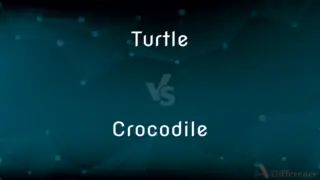Diamond vs. Emerald — What's the Difference?
Edited by Tayyaba Rehman — By Urooj Arif — Updated on April 9, 2024
Diamond is renowned for its unparalleled hardness and brilliance, making it a top choice for engagement rings; emerald is cherished for its rich green color and rarity, symbolizing renewal and wealth.

Difference Between Diamond and Emerald
Table of Contents
ADVERTISEMENT
Key Differences
Diamonds are formed deep within the Earth under extreme pressure and heat, resulting in the hardest known natural material. This makes them ideal for jewelry that withstands daily wear, such as engagement rings. On the other hand, emeralds are known for their mesmerizing green hue, which comes from traces of chromium and/or vanadium. Their beauty is often associated with royalty and luxury.
While diamonds are most valued for their clarity, cut, and sparkling brilliance, which maximize their light reflection and refraction, emeralds are prized for their color intensity and saturation. Clarity is less emphasized in emeralds; inclusions, known as "jardin," are considered acceptable and can add character.
Diamonds are measured on a scale of hardness of 10 on the Mohs scale, making them the hardest known mineral and highly resistant to scratching. This property also allows for a wide variety of cuts and shapes. Emeralds, however, have a hardness of 7.5 to 8, requiring more care in handling and setting to avoid chipping.
In terms of rarity, high-quality diamonds can be rare, especially those without any color (D grade) or with significant size. However, fine emeralds without any enhancements are considered rarer and can command higher prices per carat due to their unique color and natural inclusions.
The value of diamonds can significantly increase with size due to their rarity in larger sizes and the demand for them in jewelry. In contrast, while large emeralds are also valued, the focus remains on the intensity and purity of their green color, which is paramount in determining their worth.
ADVERTISEMENT
Comparison Chart
Formation
Deep within Earth, extreme pressure
Crustal environments, lower pressure
Hardness (Mohs)
10
7.5-8
Key Quality
Brilliance, clarity
Color intensity, inclusions
Symbolism
Strength, purity
Renewal, wealth
Care Requirements
Durable, resistant to scratching
Requires careful handling
Compare with Definitions
Diamond
A precious stone consisting of a clear and typically colorless crystalline form of pure carbon.
The diamond sparkled brilliantly under the store lights.
Emerald
Less hard than diamonds, requiring more care.
She took her emerald ring off before gardening to avoid damaging it.
Diamond
Measured by carat, cut, clarity, and color.
The jeweler explained the importance of the four Cs in selecting a diamond.
Emerald
Known for its inclusions, which can add to its uniqueness.
The inclusions in this emerald create a beautiful internal garden.
Diamond
Symbol of everlasting love.
He chose a diamond ring to propose, symbolizing eternal commitment.
Emerald
A green precious stone colored by traces of chromium and sometimes vanadium.
Her emerald necklace had a captivating, deep green hue.
Diamond
Used in industrial applications for cutting and grinding.
The factory uses diamond-tipped tools for precision cutting.
Emerald
A symbol of rebirth and love.
Emeralds are often given as gifts on twentieth and thirty-fifth anniversaries.
Diamond
The hardest known natural material.
The diamond can cut through most materials with ease.
Emerald
Valued primarily for its color intensity and purity.
The emerald's value is greatly influenced by the vibrancy of its green color.
Diamond
Diamond is a form of the element carbon with its atoms arranged in a crystal structure called diamond cubic. At room temperature and pressure, another solid form of carbon known as graphite is the chemically stable form of carbon, but diamond almost never converts to it.
Emerald
The green color of an emerald
Diamond
A precious stone consisting of a clear and colourless crystalline form of pure carbon, the hardest naturally occurring substance
A diamond ring
Emerald
Emerald is a gemstone and a variety of the mineral beryl (Be3Al2(SiO3)6) colored green by trace amounts of chromium and/or sometimes vanadium. Beryl has a hardness of 7.5–8 on the Mohs scale.
Diamond
A figure with four straight sides of equal length forming two opposite acute angles and two opposite obtuse angles; a rhombus
A sweater with a pale-blue diamond pattern
Emerald
A bright green precious stone consisting of a chromium-rich variety of beryl
An emerald necklace
Diamond
An extremely hard, highly refractive crystalline form of carbon that is usually colorless and is used as a gemstone and in abrasives, cutting tools, and other applications.
Emerald
A bright green colour
The sea glistened in shades of emerald and jade
Diamond
A piece of jewelry containing such a gemstone.
Emerald
A slender-bodied green moth, the colour of which tends to fade as the moth ages.
Diamond
A rhombus, particularly when oriented so that one diagonal extends from left to right and the other diagonal extends from top to bottom.
Emerald
A hawker dragonfly with a metallic green body.
Diamond
A red, lozenge-shaped figure on certain playing cards.
Emerald
A small hummingbird with bright metallic green plumage and darker wings and tail, found mainly in the area of the Caribbean and Central America.
Diamond
A playing card with this figure.
Emerald
Bright green in colour
Beyond the airport lay emerald hills
Diamond
Diamonds (used with a sing. or pl. verb) The suit of cards represented by this figure.
Emerald
A brilliant green to grass-green transparent variety of beryl, used as a gemstone.
Diamond
The infield.
Emerald
A strong yellowish green.
Diamond
The whole playing field.
Emerald
Of a strong yellowish green.
Diamond
Of or relating to a 60th or 75th anniversary.
Emerald
Any of various green gemstones, especially a green transparent form of beryl, highly valued as a precious stone.
Diamond
To adorn with diamonds.
Emerald
Emerald green, a colour.
Diamond
(uncountable) A glimmering glass-like mineral that is an allotrope of carbon in which each atom is surrounded by four others in the form of a tetrahedron. Category:en:Carbon
The saw is coated with diamond.
Emerald
Any hummingbird in the genera Chlorostilbon and Elvira; and some in the genus Amazilia
Diamond
A gemstone made from this mineral.
The dozen loose diamonds sparkled in the light.
Emerald
(entomology) Any of various species of dragonfly of the family Corduliidae.
Diamond
A ring containing a diamond.
What a beautiful engagement diamond.
Emerald
A size of type between nonpareil and minion, standardized as 6½-point.
Diamond
A very pale blue color.
Emerald
Of a rich green colour.
Diamond
Something that resembles a diamond.
Emerald
To ornament with, or as if with, emeralds; to make green.
Diamond
(geometry) A rhombus, especially when oriented so that its longer axis is vertical.
Emerald
A precious stone of a rich green color, a variety of beryl. See Beryl.
Diamond
(geometry) The polyiamond made up of two triangles.
Emerald
A kind of type, in size between minion and nonpare l. It is used by English printers.
Diamond
(baseball) The entire field of play used in the game.
Emerald
Of a rich green color, like that of the emerald.
Diamond
(baseball) The infield of a baseball field.
The teams met on the diamond.
Emerald
A green transparent form of beryl; highly valued as a gemstone
Diamond
(card games) A card of the diamonds suit.
I have only one diamond in my hand.
Emerald
A transparent piece of emerald that has been cut and polished and is valued as a precious gem
Diamond
A size of type, standardised as 2 point.
Diamond
The size of type between brilliant and pearl, standardized as 2-point.
Diamond
Made of, or containing diamond, a diamond or diamonds.
He gave her diamond earrings.
Diamond
Of, relating to, or being a sixtieth anniversary.
Today is their diamond wedding anniversary.
Diamond
Of, relating to, or being a seventy-fifth anniversary.
Today is their diamond wedding anniversary.
Diamond
(slang) First-rate; excellent.
He's a diamond geezer.
Diamond
To adorn with or as if with diamonds
Diamond
A precious stone or gem excelling in brilliancy and beautiful play of prismatic colors, and remarkable for extreme hardness.
Diamond
A geometrical figure, consisting of four equal straight lines, and having two of the interior angles acute and two obtuse; a rhombus; a lozenge.
Diamond
One of a suit of playing cards, stamped with the figure of a diamond.
Diamond
A pointed projection, like a four-sided pyramid, used for ornament in lines or groups.
Diamond
The infield; the square space, 90 feet on a side, having the bases at its angles.
Diamond
The smallest kind of type in English printing, except that called brilliant, which is seldom seen.
Diamond
Resembling a diamond; made of, or abounding in, diamonds; as, a diamond chain; a diamond field.
Diamond
A transparent piece of diamond that has been cut and polished and is valued as a precious gem
Diamond
Very hard native crystalline carbon valued as a gem
Diamond
A playing card in the minor suit of diamonds
Diamond
The area of a baseball field that is enclosed by 3 bases and home plate
Diamond
The baseball playing field
Common Curiosities
How are diamonds and emeralds used in jewelry?
Diamonds are favored for engagement rings and everyday wear due to their hardness, while emeralds are cherished in statement pieces for their color.
What makes diamonds so durable?
Diamonds are the hardest known natural material, making them extremely resistant to scratches and wear.
Can emeralds have inclusions?
Yes, emeralds often contain inclusions, which can add character and uniqueness to the stone.
Are diamonds or emeralds more expensive?
The price can vary greatly depending on quality, but fine emeralds can be rarer and thus more expensive per carat than diamonds.
Why are emeralds green?
Emeralds owe their green color to trace amounts of chromium and/or vanadium.
What is the Mohs scale?
The Mohs scale measures mineral hardness, with diamonds at 10 (highest) and emeralds around 7.5 to 8.
How should emeralds be cared for?
Emeralds should be handled carefully to avoid chipping and exposure to harsh chemicals.
What does the clarity of a diamond indicate?
Clarity refers to the absence of inclusions and blemishes; higher clarity diamonds are more valued.
What are some common cuts for diamonds?
Round, princess, oval, and marquise are popular diamond cuts.
How does the cut affect a diamond's appearance?
A well-cut diamond will reflect light beautifully, enhancing its brilliance and sparkle.
What is more important in evaluating an emerald's value?
The color intensity and purity are the most critical factors in determining an emerald's value.
Can diamonds and emeralds be synthetically made?
Yes, both can be created in laboratories to produce stones that are visually and chemically similar to their natural counterparts.
How do the settings for diamonds and emeralds differ?
Diamonds can be set in a variety of ways due to their hardness, while emeralds may require protective settings.
What historical significance do emeralds hold?
Emeralds have been cherished throughout history by various cultures, symbolizing wealth, power, and beauty.
Why are inclusions in emeralds sometimes considered desirable?
Inclusions can provide uniqueness and evidence of the gemstone's natural origin.
Share Your Discovery

Previous Comparison
Turtle vs. Crocodile
Next Comparison
Task vs. MissionAuthor Spotlight
Written by
Urooj ArifUrooj is a skilled content writer at Ask Difference, known for her exceptional ability to simplify complex topics into engaging and informative content. With a passion for research and a flair for clear, concise writing, she consistently delivers articles that resonate with our diverse audience.
Edited by
Tayyaba RehmanTayyaba Rehman is a distinguished writer, currently serving as a primary contributor to askdifference.com. As a researcher in semantics and etymology, Tayyaba's passion for the complexity of languages and their distinctions has found a perfect home on the platform. Tayyaba delves into the intricacies of language, distinguishing between commonly confused words and phrases, thereby providing clarity for readers worldwide.
















































